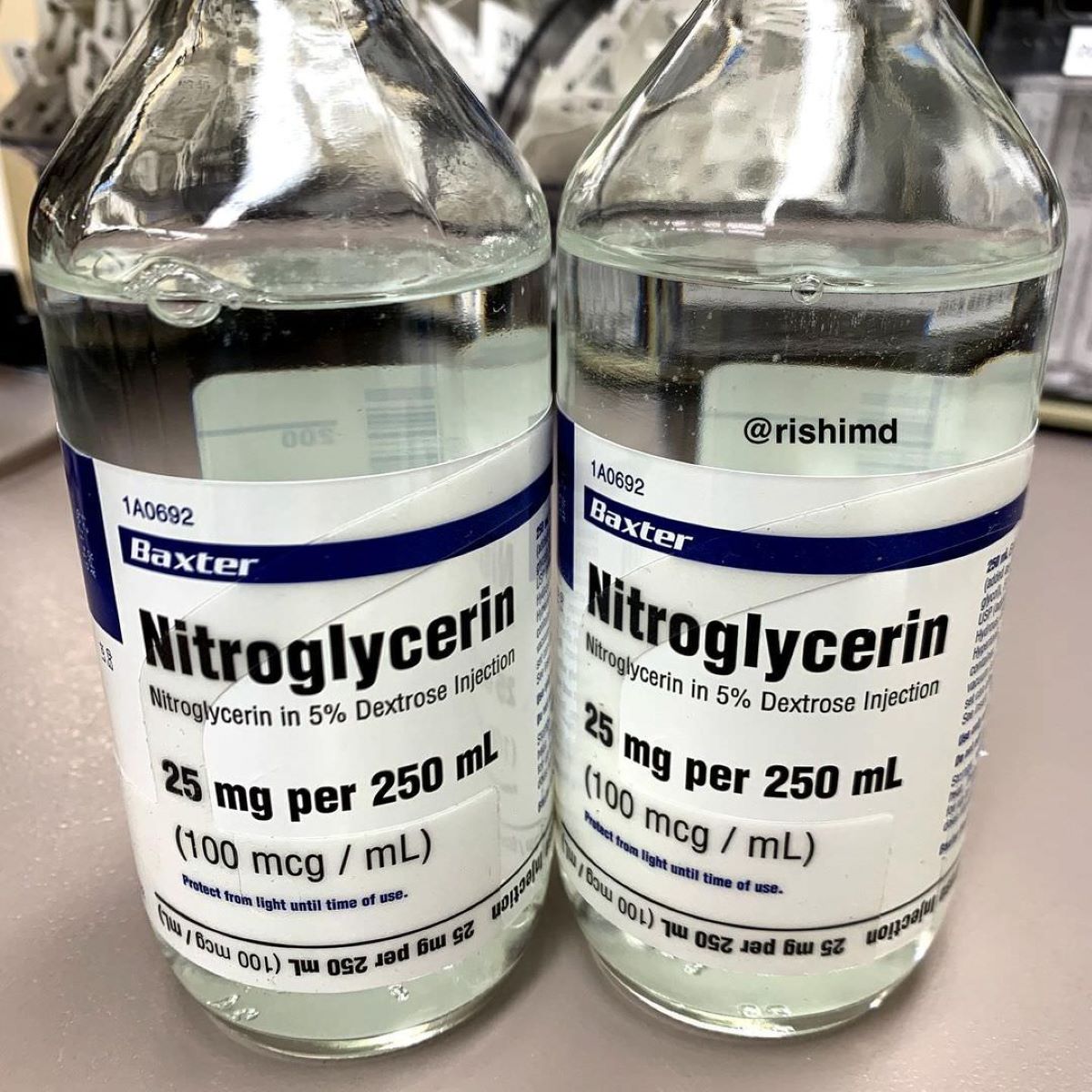

Articles
How To Store Nitroglycerin
Modified: December 7, 2023
Learn the proper methods and precautions for storing nitroglycerin safely. Check out our informative articles on how to store nitroglycerin to ensure the highest level of safety and security.
(Many of the links in this article redirect to a specific reviewed product. Your purchase of these products through affiliate links helps to generate commission for Storables.com, at no extra cost. Learn more)
Introduction
Welcome to our comprehensive guide on how to store nitroglycerin safely. Nitroglycerin is a highly sensitive and potentially explosive substance, commonly used in various industrial and medical applications. Due to its volatility, it is crucial to handle and store nitroglycerin with extreme caution to prevent accidents and ensure the safety of individuals and surroundings.
In this guide, we will discuss the necessary safety precautions, how to choose the right storage container, the ideal storage location, temperature and humidity control, proper handling and transportation methods, and the importance of having an emergency response plan. By following these guidelines, you can minimize the risks associated with storing nitroglycerin and confidently ensure the safety of your facility and personnel.
Key Takeaways:
- Prioritize safety by following strict precautions, choosing suitable storage containers, and maintaining ideal storage conditions to minimize risks when handling and storing nitroglycerin.
- Develop a comprehensive emergency response plan, provide thorough training, and ensure compliance with regulations to effectively respond to emergencies and protect personnel when working with nitroglycerin.
Read more: How To Store Nitroglycerin Tablets
Safety Precautions
When it comes to handling and storing nitroglycerin, safety should always be your top priority. This highly sensitive explosive material requires strict adherence to safety precautions to minimize the risk of accidents. Here are some essential safety measures to follow:
1. Protective Equipment:
Ensure that all personnel involved in handling nitroglycerin wear appropriate protective equipment such as gloves, safety glasses, and fire-resistant clothing. This protective gear will provide an extra layer of protection in case of accidental spillage or ignition.
2. No Smoking Policy:
Strictly enforce a no smoking policy in and around areas where nitroglycerin is stored. Smoking near the substance can lead to ignition, as nitroglycerin is highly flammable. Make sure to clearly display “No Smoking” signs and educate all employees about the risks associated with smoking in the vicinity of nitroglycerin.
3. Proper Labeling:
Ensure that all containers holding nitroglycerin are clearly labeled with the necessary information, including the chemical name, hazard symbols, and handling instructions. This will help prevent confusion and ensure that everyone is aware of the potential dangers associated with the substance.
Read more: How To Store Store-Bought Bread
4. Restricted Access:
Limit access to nitroglycerin storage areas to authorized personnel only. By implementing restricted access protocols, you can prevent unauthorized individuals from tampering with or mishandling the substance, reducing the risk of accidents and potential harm.
5. Regular Training:
Provide thorough training to all employees who handle nitroglycerin. This training should include proper handling techniques, emergency response procedures, and a clear understanding of the risks associated with nitroglycerin. Regular refresher training sessions should also be conducted to keep everyone up to date with safety protocols and best practices.
6. Fire Safety Measures:
Ensure that appropriate fire safety measures are in place, including installing fire extinguishers and fire suppression systems in close proximity to the nitroglycerin storage area. Conduct regular checks to ensure that all fire safety equipment is in good working condition and that employees are familiar with their operation.
By strictly adhering to these safety precautions, you can significantly reduce the risk of accidents and ensure the overall safety of your workplace when handling and storing nitroglycerin.
Choosing the Right Storage Container
Selecting the appropriate storage container for nitroglycerin is essential to maintain its stability and prevent any accidental spills or leaks. Here are some factors to consider when choosing the right storage container:
Read more: How To Store Basil From Grocery Store
1. Compatibility:
The storage container must be made of a compatible material that is resistant to nitroglycerin. Suitable materials include stainless steel, aluminum, or specialized plastics that can withstand the corrosive and reactive nature of the substance. Avoid using containers made of materials such as glass or certain types of rubber, as they may react with nitroglycerin and compromise its integrity.
2. Sealing Capability:
Ensure that the storage container has a tight sealing mechanism to prevent any leakage or evaporation of nitroglycerin. A secure seal will also help minimize the risk of exposure to external factors, such as air or moisture, which can degrade the substance over time.
3. Pressure Relief Valve:
If you are storing nitroglycerin in a pressurized container, make sure it is equipped with a pressure relief valve. This valve allows excess pressure to escape, preventing the container from rupturing or exploding in the event of an internal pressure buildup.
4. Size and Capacity:
Consider the amount of nitroglycerin you need to store and choose a container with an appropriate size and capacity. Avoid overfilling the container, as it can increase the risk of accidental spills or leaks. It is also important to have adequate space within the container to accommodate any expansion or contraction of the substance.
Read more: How To Store Basil From Store
5. Compatibility with Storage Conditions:
Take into account the storage conditions required for nitroglycerin, such as temperature and humidity control. Ensure that the storage container is suitable for maintaining the desired storage conditions. For example, if nitroglycerin requires refrigeration, choose a container that can accommodate a refrigeration system.
6. Durability and Stability:
Select a storage container that is durable and stable to withstand potential impacts or harsh environmental conditions. The container should also be designed to withstand potential fires or other emergencies, minimizing the risk of damage or rupture.
By carefully considering these factors, you can choose the right storage container that will effectively preserve the stability and integrity of nitroglycerin, ensuring safe and secure storage.
Storage Location
Selecting an appropriate storage location for nitroglycerin is crucial to ensure the safety of both the substance and the surrounding environment. Here are some key factors to consider when determining the ideal storage location:
1. Ventilation:
Choose a well-ventilated location for storing nitroglycerin to minimize the accumulation of any vapors that may be released. Proper ventilation helps reduce the risk of explosive hazards by maintaining a consistent airflow and preventing the buildup of potentially harmful gases.
Read more: How To Store Hoses
2. Separation From Ignition Sources:
Keep nitroglycerin storage areas separate from any potential sources of ignition, such as open flames, sparks, or electrical equipment that may generate heat or static electricity. Maintaining a safe distance from these ignition sources helps reduce the risk of accidental ignition or explosions.
3. Distance from Incompatible Materials:
Store nitroglycerin away from any materials that may react or pose a compatibility risk. These include strong oxidizers, acids, or materials that can release heat or generate gases when in contact with nitroglycerin. Maintaining a safe distance from incompatible materials minimizes the potential for hazardous reactions.
4. Temperature Control:
Ensure that the storage location allows for temperature control, especially if nitroglycerin requires specific temperature conditions. Extreme temperatures, both hot and cold, can compromise the stability of the substance and increase the risk of accidental decomposition or instability. Utilize temperature control systems, such as refrigeration units or climate-controlled storage areas, to maintain the desired temperature range.
5. Security Measures:
Implement adequate security measures to prevent unauthorized access to the nitroglycerin storage area. Restricted access, surveillance systems, and alarms can help deter theft or tampering and ensure that only authorized personnel can enter the storage facility. This helps maintain the integrity and safety of the stored nitroglycerin.
Read more: How To Store A Bike
6. Stability and Structural Integrity:
Choose a storage location that is structurally sound and stable to withstand potential accidents or emergencies. The location should be able to withstand physical impacts, fires, floods, or other unforeseen events. Regular inspections and maintenance of the storage area are essential to ensure its ongoing stability and integrity.
By considering these factors, you can identify the most suitable storage location for nitroglycerin, minimizing the risks associated with its storage and maintaining a safe environment for all personnel and facilities. Remember to comply with local regulations and industry standards when selecting the storage location.
Temperature and Humidity Control
Proper temperature and humidity control are crucial factors to ensure the stability and integrity of stored nitroglycerin. Nitroglycerin is sensitive to both heat and moisture, and maintaining optimal storage conditions is essential to prevent degradation and maintain its safety. Here are some guidelines for temperature and humidity control:
1. Temperature Range:
Nitroglycerin should be stored within a specific temperature range to maintain its stability. Ideally, the storage temperature should be maintained between 15-25 degrees Celsius (59-77 degrees Fahrenheit). Extreme temperatures, whether too high or too low, can cause the substance to decompose, become unstable, or lose its efficacy. Use temperature monitoring systems to ensure the storage area remains within the recommended range.
2. Avoid Temperature Fluctuations:
Frequent or drastic temperature fluctuations can also negatively impact the stability of nitroglycerin. Temperature fluctuations can cause expansion and contraction, potentially leading to leaks or a change in the physical properties of the substance. Maintain a stable and consistent temperature within the storage area to minimize the risk of these fluctuations.
Read more: How To Store Pears
3. Humidity Control:
Humidity control is equally important, as excess moisture can cause nitroglycerin to degrade and become less stable. Ensure the storage area has low humidity levels to prevent moisture absorption. Consider employing dehumidifiers or desiccants to maintain the desired moisture levels within the storage space. Regularly monitor humidity levels and take necessary measures to prevent moisture buildup.
4. Prevent Condensation:
Condensation can occur when there is a significant difference in temperature between the stored nitroglycerin and its surroundings. The formation of condensation can introduce moisture, potentially compromising the stability of the substance. To prevent condensation, maintain a stable temperature within the storage area and ensure proper insulation to minimize temperature variations.
5. Thermal Insulation:
Insulate the storage area to help maintain a consistent temperature. Proper insulation can prevent heat transfer from the environment, reducing the risk of temperature fluctuations. Consider using insulation materials that are resistant to heat and moisture to ensure maximum effectiveness.
6. Monitoring and Regular Inspection:
Regularly monitor and document the temperature and humidity levels within the storage area. Conduct routine inspections to identify any potential issues, such as equipment failures or leaks, that may affect the storage conditions. Promptly address any deviations or abnormalities to maintain optimal temperature and humidity control.
By implementing proper temperature and humidity control measures, you can extend the shelf life of nitroglycerin, ensure its stability, and minimize the risk of accidents or degradation associated with improper storage conditions. Remember to comply with regulatory requirements and industry best practices pertaining to temperature and humidity control for nitroglycerin storage.
Read more: How To Store Sweaters
Handling and Transporting Nitroglycerin
Proper handling and transportation of nitroglycerin are critical to ensure the safety of individuals involved and to prevent accidents or spills that could lead to disastrous consequences. Here are some guidelines to follow when handling and transporting nitroglycerin:
1. Training and Certification:
Ensure that all personnel involved in handling nitroglycerin have received proper training and certification. This training should cover the safe handling procedures, emergency response protocols, and the potential risks associated with nitroglycerin. Regular refresher courses should also be conducted to keep employees updated.
2. Personal Protective Equipment (PPE):
All individuals handling nitroglycerin should wear appropriate personal protective equipment (PPE) to minimize the risk of accidental exposure or contact. This may include gloves, safety goggles, and fire-resistant clothing. The use of PPE helps to protect against potential hazards and ensures the safety of personnel.
3. Secure Packaging:
When transporting nitroglycerin, ensure that it is securely packaged to prevent leakage or accidental spills. Use containers specifically designed for transporting hazardous materials and ensure they are properly sealed and labeled with the necessary information, such as the chemical name, hazard symbols, and handling instructions.
Read more: How To Store Chayote
4. Stability Considerations:
Take into account the stability and sensitivity of nitroglycerin during transportation. Avoid sudden shocks, vibrations, or impacts that could trigger an explosive reaction. Use shock-absorbing materials and secure the containers in a stable position within the transport vehicle to minimize movement.
5. Compatibility:
When transporting nitroglycerin, ensure that it is not in close proximity to incompatible substances. Separate it from materials that can react with or potentially compromise the stability of nitroglycerin. Refer to the safety data sheets and consult with transportation experts to determine the appropriate segregation requirements.
6. Compliance with Regulations:
Adhere to all local, regional, and international regulations governing the transportation of hazardous materials, including nitroglycerin. Familiarize yourself with the specific regulations related to labeling, documentation, vehicle requirements, and driver qualifications to ensure compliance and minimize the risk of legal and safety issues.
7. Emergency Response Plan:
Develop and implement a comprehensive emergency response plan specifically tailored to handling and transporting nitroglycerin. This plan should include procedures for addressing accidents, spills, fires, or any other potential emergencies. Educate all personnel involved in the transport process about their roles and responsibilities in case of an emergency.
By following these guidelines, you can safely handle and transport nitroglycerin, minimizing the risks associated with its use and ensuring the well-being of all individuals involved. It is crucial to prioritize safety at all times and comply with all applicable regulations and best practices.
Read more: How To Store Mandarins
Emergency Response Plan
Developing and implementing a comprehensive emergency response plan is essential when handling and storing nitroglycerin. Having a well-prepared plan ensures that everyone involved is aware of the necessary steps to take in the event of an emergency, which can help minimize the potential risks and ensure the safety of individuals and the surrounding environment. Here are some key elements to consider when creating an emergency response plan for nitroglycerin:
1. Emergency Contacts:
Maintain a list of relevant emergency contacts, including local emergency services, hazardous materials response teams, and supervisors within your organization. Ensure that this contact list is readily accessible to all personnel involved in handling and storing nitroglycerin.
2. Communication Procedures:
Establish clear communication channels and procedures to notify all personnel in case of an emergency. This may include alarms, intercom systems, or designated personnel responsible for initiating the emergency response. Clearly communicate the actions that should be taken upon receiving an emergency notification or alert.
3. Evacuation Plan:
Develop an evacuation plan that clearly outlines evacuation routes, assembly points, and procedures. Ensure that all personnel understand the evacuation plan and conduct regular drills to practice evacuation procedures. Assign specific roles and responsibilities to designated individuals to facilitate a smooth and orderly evacuation process.
Read more: How To Store Chains
4. First Aid and Medical Assistance:
Ensure that trained personnel are available to provide first aid in the event of an accident or injury. Establish protocols for accessing medical assistance promptly, including contacting emergency medical services and providing them with accurate and essential information about the incident.
5. Spill and Leak Response:
Incorporate specific procedures for addressing spills or leaks of nitroglycerin in your emergency response plan. Provide guidelines on containing the spill, mitigating any potential hazards, and safely cleaning up the affected area. Include proper disposal methods for contaminated materials and ensure that personnel are trained on the appropriate spill response procedures.
6. Fire Response:
Develop fire response procedures that are specific to situations involving nitroglycerin. Include guidelines on extinguishing fires, utilizing fire suppression systems, and evacuating the area in case of fire. Ensure that all personnel are trained on fire safety measures, and regularly inspect and maintain fire extinguishers and fire suppression systems.
7. Training and Drills:
Conduct regular training sessions and drills to keep personnel updated on emergency response procedures. Training should cover the specific hazards associated with working with nitroglycerin, proper use of personal protective equipment (PPE), and the steps to take during different emergency scenarios. Regular drills help to reinforce knowledge, identify areas for improvement, and ensure that everyone is familiar with their roles in emergency situations.
Remember to review and update your emergency response plan periodically to incorporate any changes in regulations, best practices, or facility layouts. By having a well-prepared emergency response plan in place, you can effectively respond to emergencies, mitigate potential risks, and protect the safety of personnel and the environment when handling and storing nitroglycerin.
Read more: How To Store Bacon
Conclusion
Safely handling and storing nitroglycerin is of utmost importance to ensure the well-being of individuals and prevent accidents that can have catastrophic consequences. By following the safety precautions outlined in this guide, choosing the right storage container, selecting an appropriate storage location, controlling temperature and humidity, and implementing proper handling and transportation procedures, you can significantly minimize the risks associated with nitroglycerin.
Remember to provide comprehensive training to all individuals involved in the handling and storage of nitroglycerin, and regularly review and update their knowledge. Strong emphasis should be placed on the use of personal protective equipment (PPE), adherence to safety protocols, and understanding of emergency response procedures.
Proper labeling and clear signage around nitroglycerin storage areas will help keep everyone informed about the potential hazards and safe handling practices. It is crucial to comply with local regulations and industry standards related to the storage and transportation of nitroglycerin to maintain legal and ethical requirements.
Always be prepared for emergencies by establishing an emergency response plan and conducting regular drills. This ensures that all personnel are familiar with their roles and responsibilities in emergency situations, and that communication channels are well-established to swiftly address any incidents that may arise.
By following these guidelines and continually prioritizing safety, you can confidently handle and store nitroglycerin, minimizing the risks and ensuring a secure and safe environment for all. Proper handling and storage practices are essential to prevent accidents, protect personnel, and maintain the integrity and stability of nitroglycerin.
Frequently Asked Questions about How To Store Nitroglycerin
Was this page helpful?
At Storables.com, we guarantee accurate and reliable information. Our content, validated by Expert Board Contributors, is crafted following stringent Editorial Policies. We're committed to providing you with well-researched, expert-backed insights for all your informational needs.





0 thoughts on “How To Store Nitroglycerin”